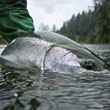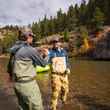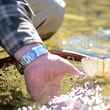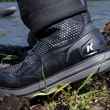Fishing is never better or worse, I say, just different. That said, September might just be the worst month of the year for trout fishing in the Southern Appalachians, second only to August, perhaps, or October in years when the rain comes late. Either way, low, warm water is the name of the game during this period, and knowing how to tackle it both tactically and responsibly will help you to become a better, more versatile angler, and save you from spending some of the most beautiful days of the year inside doing less important things.
Consider these points when heading for the trout-holding hills with a long rod when the streamflows are at an all-year low.
Hunt
Literally. By the month of September, most states’ squirrel seasons are open, and if you’ve never spent a crisp early-autumn morning in a hardwood grove full of chattering bushytails, you’re missing out on one of my favorite traditions. If you have a taste for locally grown meat or you tie flies, take along a .22 long rifle. Squirrel is mighty tasty and their fur makes for an excellent dubbing when blended correctly. Squirrel tail is also one of my favorite materials for both nymphs and streamers. It’s like bucktail, but finer and more responsive. When it’s warm and there’s little water, hit the creekbottoms. Squirrels gotta’ drink, too.
But if you’re intent on chasing trout, you need to hunt your fish, more so than in any other condition. If you don’t already wear camouflage or otherwise drab clothing, do so. Examine the water you intend to fish from a high bank or rock if you can without hulking over the pool. Low-powered binoculars may be helpful. When approaching the water, stay low, walk slowly, mind your shadow, and try to avoid crunching on rocks and gravel. Stay out of the water if at all possible, as wakes and vibrations are much more obvious in slow moving water and will spook fish.
Wear Orange
This is, in my opinion, crucial, and often overlooked. Check your local hunting regulations before heading into public land that gets heavy hunting pressure dressed in camouflage or drab. If hunters are required to wear blaze orange on that date, so should you. Your safety outweighs stealth.
Fish Cover
Submerged logs, boulders—fish it if you’ve got it. However, often times when water drops significantly, traditional cover, often found on the edges of rivers, becomes exposed. Thus, elements like shadows, riffles, and rock edges become the best cover available—anything that might hide a fish from above.
Furthermore, as water drops, oxygenating mechanisms like plunge pools and heavy riffles are subdued. Water is also generally warmer than it would be during the spring, late-fall, or winter. Thus oxygen can become low, and fish will be drawn to high-oxygen, thermal refuges, like the heads of prominent pools, springheads, and the mouths of heavily shaded tributaries.
Fish low light
Low water is almost always exceptionally clear. Fish become very spooky in clear water, and, if you have brown trout, they may become nocturnal or particularly crepuscular (active at dawn and dusk). So fish when the light is low—early and late in the day, or during periods of poor weather.
Lighten your rig
With glassy, slow water, it may pay to go light. Start with your typical rig, and lighten or lengthen your tippet if you get consistent refusals or aren’t catching fish. If your fly line hitting the water spooks fish excessively, consider underlining if you fish a rod with an action that will allow it. Try to avoid fishing a smaller rod, as this will only prolong the fight, increasing the possibility that the fish will not recover.
Outcompete the leaf hatch
Defoliating times differ, but, generally, by the end of September or early October, fallen leaves and other organic matter will begin to clutter the water. It’s my theory that the “leaf hatch” can hide some offerings from the trout, minimizing your chances of hooking one. To combat this, consider upsizing your nymphs a size, fishing dark colors, or fishing streamers. If dead-drifting isn’t earning takes, impart small twitches, even to your nymphs and dry flies. It might be all it takes to distinguish it from drifting debris.
Scout
Maybe the most beneficial thing you can do for your fall fishing season is scouting for fall spawning sites when the water is low in September. Both brook and brown trout are fall spawners, and the spawning period represents the greatest opportunity to tangle with a large specimen of the latter. Spend a day walking several miles of big brown trout water, keeping an eye out for stretches of river with the ideal pea-gravel bottom, as well as overhead cover, shade, and flow (oxygen). When the full moon in October rolls around, you’ll be able to target the holding water near these spots to catch big browns on the move. Never target redds or actively spawning fish. They are in the midst of an activity too critical to the future of fishing to be interrupted.
Don’t
In many locations that only marginally support trout, water temperatures in September and early October can be on the warm extreme of the species’ tolerance range. Part of being a responsible angler is knowing when to leave sensitive fish alone. Take water temperatures where you fish to ensure that the environment is suitable for fish to recover after a fight.
When the air turns crisp and the mountains catch fire with the dying embers of a long summer, but the streamflows are still bottomed out, consider these tips in making the most of low water, and begin your journey in conquering what is probably the most difficult and discouraging of fishing conditions.
































Comments
Michelle replied on Permalink
This article was so educational! I love to fish and wish I could find a fishing friend to learn from. Take a class, something to learn more like this. I wouldn't want to do something to endanger the species, knowing this info here, really opened my eyes.
Pages